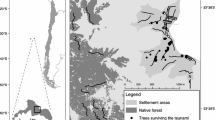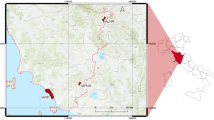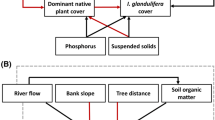Abstract
Ungulates have been widely introduced to new locations, often increasing to high densities that impact on native plant communities. Himalayan tahr (Hemitragus jemlahicus) were introduced to New Zealand in 1904 and now occupy about 9600 km2 of the Southern Alps. Managers aim to control tahr to reduce impacts to native montane grasslands. We used a network of 111 permanent plots in eight catchments to estimate the long-term impacts of tahr on total vegetation cover and snow tussock (Chionochloa spp.) height. The proportion of sub-plots containing faecal pellets was used as a measure of tahr activity. Total vegetation cover increased during the study period but declined non-linearly with increasing tahr activity, with the most rapid decline occurring as tahr activity increased from low levels (i.e. a highly-vulnerable relationship). Tussock height declined weakly as a function of time during the study period, but declined strongly with increasing tahr activity (a proportionate relationship). A proportional effect of tahr activity on adult tussock height and a non-linear logarithmic effect of tahr activity on vegetation cover indicate that species other than tussocks were highly sensitive to tahr activity, even at very low levels. We conclude that tahr had significantly impacted total vegetation cover and tussock height during 1990–2013. Although vegetation cover appears to still be recovering from the high tahr densities that occurred prior to the 1970s, managers need to control tahr to lower levels, to further reduce their impacts on montane grasslands.





Similar content being viewed by others
References
Atkinson IAE, Greenwood RM (1989) Relationships between moas and plants. N Z J Ecol 12:67–96
Augustine DJ, McNaughton SJ (1998) Ungulate effects on the functional species composition of plant communities: herbivore selectivity and plant tolerance. J Wildl Manag 62:1165–1183
Bates D et al (2014) lme4: linear mixed-effects models using Eigen and S4. R package version 1.0-6 edn. http://CRAN.R-project.org/package=lme4
Bee JN et al (2010) Spatio-temporal feeding selection of red deer in a mountanious landscape. Austral Ecol 35:752–764
Beguin J, Pothier D, Côté SD (2011) Deer browsing and soil disturbance induce cascading effects on plant communities: a multilevel path analysis. Ecol Appl 21:439–451
Burnham KP, Anderson DR (2002) Model selection and multimodel inference: a practical information-theoretic approach. Springer, New York
Caughley G (1970a) Eruption of ungulate populations, with emphasis on Himalayan thar in New Zealand. Ecology 51:53–72
Caughley G (1970b) Liberation, dispersal and distribution of Himalayan thar (Hemitragus jemlahicus) in New Zealand. N Z J Sci 10:23–33
Coomes DA et al (2003) Factors preventing the recovery of New Zealand forests following control of invasive deer. Conserv Biol 17:450–459
Côté SD et al (2004) Ecological impacts of deer overabundance. Annu Rev Ecol Evol Syst 35:113–147
Crawley MJ (2013) The R book. Wiley, West Sussex
Cruz J, Thomson C, Parkes JP (2014) Impact of himalayan tahr (Hemitragus jemlahicus) on snow tussocks in the Southern Alps, New Zealand. Landcare Research, Lincoln, p 28
Department of Conservation (1993) Himalayan thar control plan. Department of Conservation, Christchurch, p 68
Donne TE (1924) The game animals of New Zealand: an account of their introduction, acclimatization, and development. J Murray, London
Duncan K, Holdaway R (1989) Footprint pressures and locomotion of moas and ungulates and their effects on the New Zealand indigenous biota through trampling. N Z J Ecol 12:97–101
Evju M et al (2009) Grazing responses in herbs in relation to herbivore selectivity and plant traits in an alpine ecosystem. Oecologia 161:77–85
Flueck WT (2010) The slippery slope of exporting invasive species: the case of Himalayan tahr arriving in South America. Biol Invasions 12:1467–1475
Flux JE (1967) Hare numbers and diet in an alpine basin in New Zealand. Proc N Z Ecol Soc 14:27–33
Forsyth DM (1997) Ecology and management of Himalayan thar and sympatric chamois in the southern alps, New Zealand. PhD dissertation, Lincoln University, Lincoln
Forsyth DM (1999) Long-term harvesting and male migration in a New Zealand population of Himalayan tahr Hemitragus jemlahicus. J Appl Ecol 36:351–362
Forsyth DM, Caley PA (2006) Testing the irruptive paradigm of large-herbivore dynamics. Ecology 87:297–303
Forsyth DM, Hickling GJ (1998) Increasing Himalayan tahr and decreasing chamois densities in the eastern Southern Alps, New Zealand: evidence for interspecific competition. Oecologia 113:377–382
Forsyth DM, Tustin KG (2005) Himalayan tahr. In: King CM (ed) The handbook of New Zealand mammals. Oxford University Press, Melbourne, pp 361–373
Forsyth DM, Parkes JP, Hickling GJ (2000) A case for multi-species management of sympatric herbivore pest impacts in the central Southern Alps, New Zealand. N Z J Ecol 24:97–103
Forsyth DM et al (2010) Impacts of introduced deer and extinct moa on New Zealand ecosystems. N Z J Ecol 34:48–65
García MB, Picó FX, Ehrlén J (2008) Life span correlates with population dynamics in perennial herbaceous plants. Am J Bot 95:258–262
Groffman PM et al (2006) Ecological thresholds: the key to successful environmental management or an important concept with no practical application? Ecosystems 9:1–13
Hickling GJ, Forsyth DM (2000) Assessment of the extent of alpine areas being utilised as possum habitat in Westland. Lincoln University, Lincoln
Hone J (2007) Wildlife damage control. CSIRO Publishing, Collingwood
Horsley SB, Stout SL, deCalesta DS (2003) White-tailed deer impact on the vegetation dynamics of a northern hardwood forest. Ecol Appl 13:98–118
Husheer SW, Allen RB, Robertson AW (2006) Suppression of regeneration in New Zealand mountain beech forests is dependent on species of introduced deer. Biol Invasions 8:823–834
Kelly D et al (2000) Predation satiation and extreme mast seeding in 11 species of Chionochloa (Poaceae). Oikos 90:477–488
Körner C (1999) Alpine plant life: functional plant ecology of high mountain ecosystems. Springer, Heidelberg
Lee WG et al (2000) Long-term effects of defoliation: incomplete recovery of a New Zealand alpine tussock grass, Chinochloa pallens, after 20 years. J Appl Ecol 37:348–355
Lever C (1994) Naturalized animals: the ecology of successfully introduced species. Cambridge University Press, Cambridge
Long JL (2003) Introduced mammals of the world: their history, distribution and influence. CSIRO Publishing, Collingwood
Mark AF et al (1989) An ecological survey of the central part of the Eyre ecological district, northern Southland, New Zealand. J R Soc N Z 19:349–384
Mayer R et al (2009) Effects of grazing exclusion on species composition in high-altitude grasslands of the Central Alps. Basic Appl Ecol 10:447–455
McCarthy MA, Possingham HP (2007) Active adaptive management for conservation. Conserv Biol 21:956–963
Molau U (2010) Long-term impacts of observed and induced climate change on tussock tundra near its southern limit in northern Sweden. Plant Ecol Divers 3:29–34
Mysterud A (2006) The concept of overgrazing and its role in management of large herbivores. Wildl Biol 12:129–141
Norbury GL et al (2015) Density-impact functions for terrestrial vertebrate pests and indigenous biota: guidelines for conservation managers. Biol Conserv 191:409–420
Nugent G, Parkes JP, Tustin KG (1987) Changes in the density and distribution of red deer and wapiti in northern Fiordland. N Z J Ecol 10:11–21
Nugent G, Fraser W, Sweetapple PJ (2001) Top down or bottom up? Comparing the impacts of introduced arboreal possums and ‘terrestrial’ ruminants on native forests in New Zealand. Biol Conserv 99:65–79
Ohashi H et al (2014) The impact of sika deer on vegetation in Japan: setting management priorities on a national scale. Environ Manag 54:631–640
Pardo I et al (2015) Long-term responses of plant communities to herbivore exclusion at high elevation grasslands. Biodivers Conserv 24:3033–3047
Parkes JP (2006) Does commercial harvesting of introduced wild mammals contribute to their management as conservation pests? In: Allen RB, Lee G (eds) Biological invasions in New Zealand. Springer, Heidelberg, pp 407–420
Parkes JP, Forsyth DM (2008) Interspecific and seasonal dietary differences of Himalayan thar, chamois and brushtail possums in the central Southern Alps, New Zealand. N Z J Ecol 32:46–56
Parkes JP et al (2006) Adaptive management experiments in vertebrate pest control in New Zealand and Australia. Wildl Soc B 34:229–236
Pekelharing CJ, Parkes JP, Barker RJ (1998) Possum (Trichosurus vulpecula) densities and impacts on fuchsia (Fuchsia excorticata) in south westland, New Zealand. N Z J Ecol 22:197–203
R Core Team (2013) R: a language for statistical computing. R Foundation for Statistical Computing, Vienna, Austria. https://www.R-project.org/
Rose AB, Platt KH (1987) Recovery of northern Fiordland alpine grasslands after reduction in the deer population. N Z J Ecol 10:23–33
Rose AB, Platt KH (1990) Age-states, population structure, and seedling regeneration of Chionochloa pallens in Canterbury alpine grasslands, New Zealand. J Veg Sci 1:89–96
Rose AB, Platt KH (1992) Snow tussock (Chionochloa) population responses to removal of sheep and European hares, Canterbury, New Zealand. N Z J Bot 30:373–382
Simberloff D (1995) Why do introduced species appear to devastate islands more than mainland areas? Pac Sci 49:87–97
Stritar ML et al (2010) Introduced ungulate herbivore alters soil processes after fire. Biol Invasions 12:313–324
Tanentzap AJ et al (2009) Landscape-level vegetation recovery from herbivory: progress after four decades of invasive red deer control. J Appl Ecol 46:1064–1072
Tustin KG, Challies CN (1978) The effects of hunting on the numbers and group sizes of Himalayan thar (Hemitragus jemlahicus) in Carneys creek, Rangitata catchment. N Z J Ecol 1:153–157
Tustin KG, Parkes JP (1988) Daily movement and activity of female and juvenile Himalayan thar (Hemitragus jemlahicus) in the eastern southern alps, New Zealand. N Z J Ecol 11:51–59
Wardle P (1991) Vegetation of New Zealand. Cambridge University Press, Cambridge
Wardle DA et al (2001) Introduced browsing mammals in New Zealand natural forests: aboveground and belowground consequences. Ecol Monogr 71:587–614
Wright DM et al (2012) Impacts of culling and exclusion of browsers on vegetation recovery across New Zealand forests. Biol Conserv 153:64–71
Yokomizo H et al (2009) Managing the impact of invasive species: the value of knowing the density-impact curve. Ecol Appl 19:376–386
Zuur AF et al (2009) Mixed effects models and extensions in ecology with R. Springer, New York
Acknowledgments
This study was funded by the New Zealand Department of Conservation. We thank all the field staff and contractors who helped with field work, particularly Morgan Coleman (Landcare Research) and Neil Bolton (DOC). The late Phil Knightbridge was instrumental in keeping the study going long term. Kerry Weston (Department of Conservation) helped sort out the long-term datasets. A. Gormley, S. Richardson, T. Easdale and G. Norbury (all Landcare Research) and two anonymous reviewers provided helpful comments on previous versions of the manuscript.
Author information
Authors and Affiliations
Corresponding author
Electronic supplementary material
Below is the link to the electronic supplementary material.
Rights and permissions
About this article
Cite this article
Cruz, J., Thomson, C., Parkes, J.P. et al. Long-term impacts of an introduced ungulate in native grasslands: Himalayan tahr (Hemitragus jemlahicus) in New Zealand’s Southern Alps. Biol Invasions 19, 339–349 (2017). https://doi.org/10.1007/s10530-016-1283-2
Received:
Accepted:
Published:
Issue Date:
DOI: https://doi.org/10.1007/s10530-016-1283-2




